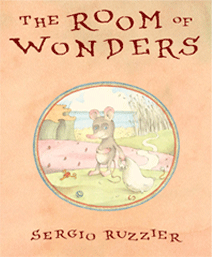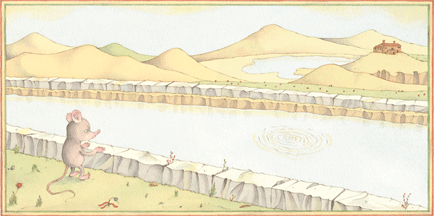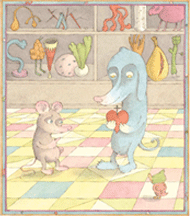


A Parents’ Choice Gold Award
For each of us, the definition of a treasured found object is different.
In the eyes of the collector, an old key, a golden autumn leaf, a fallen feather from
a red-tailed hawk, or a seashell is remarkable. An old postcard that
survived writer and recipient, a marble from a best friend’s collection, or a rusted
toy truck, recalls a person, time, or place that we cherish or ponder.
Here, Pius Pelosi is a pack rat with the eye of an art collector.
In The Room of Wonders, Pius exhibits his treasures with the skill of a curator.
When visitors come to admire his collection, Pius is happy to tell the story of
how he came upon all or any of the marvelous objects on display.
But when the admirers repeatedly question the beauty of a plain small gray
pebble and the validity of its prominence, Pius’ belief in the integrity of his
collection is shaken.
With his signature muted colors and illustrative style, Sergio Ruzzier delivers
this philosophical tale with warmth and wit and charm.
Claire S. Green ©2006 Parents' Choice
School Library Journal
Pius Pelosi, a young pack rat, has a spot set aside to house his collection of
miscellaneous items. Full of curiosities, including twigs, feathers, sea glass, shells,
and buttons, the room draws visitors from far and wide eager to learn about the
objects and how the rodent discovered them. One item-"a very plain-looking
small gray pebble"-is given particular prominence. Although it is special to him
because it is the first thing he ever collected, his guests consider it too ordinary to
display. Ultimately, he bows to their pressure, removing it and tossing it into the
river. Saddened by its absence, Pius gives away the remaining articles and vows
to stop searching for new ones. On his first venture out, however, he spies a small
gray pebble and his interest in collecting is once again sparked. Ruzzier's gently
told story is perfectly pitched for the picture-book crowd. The lesson is subtle but
will lead to much discussion. The softly shaded illustrations, done in soothing
pastel colors, show a medieval-looking village and the surrounding countryside.
Pius, with his sweetly comical expressions, reflects the quiet tone of the text.
In the tradition of Leo Lionni's Frederick and William Steig's Sylvester, Pius is a
character worth meeting.
Maura Bresnahan, High Plain Elementary School, Andover, MA
 |
 |